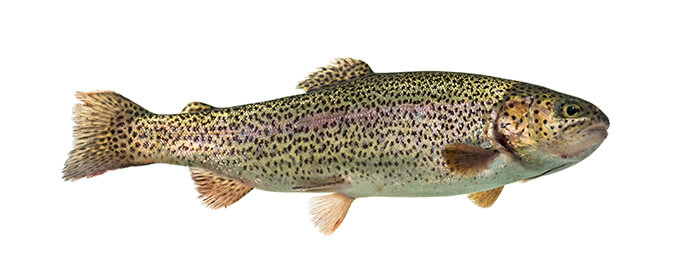SPECIES OUTLINE: RAINBOW TROUT (Oncorhynchus mykiss)

Rainbow trout (Oncorhynchus mykiss) are one of the most extensively cultured species in the world. Globally, recent estimates indicate that the production of rainbow trout is valued at 3.6 billion USD representing a volume of 848,100 tonnes (Tacon, 2019; FAO, 2020). Many countries culture rainbow trout; however, the majority of production is based in Iran, Turkey, Chile, and Norway. Most of the growth in this sector over the last two decades has been a result of expansions of the freshwater industry in Iran and Turkey which accounted for 43% of rainbow trout grown in freshwater in 2016 (Seafish, 2021). Norway and Chile were the leading producers of marine-grown trout over the same period. Canada also has a small, but dynamic and growing rainbow trout industry predominantly centered in Ontario. In 2018, production of rainbow trout in Ontario was estimated to be 5,416 tonnes with a farm-gate value of 29 million CAD (Moccia et al., 2019).
The production of rainbow trout is diverse and occurs in both freshwater and saltwater. Production is characterized by a variety of systems including freshwater ponds, tanks and raceways or freshwater and saltwater cages (net-pens). Production operations may consist of vertically-integrated farms which grow broodstock and produce fish from eggs to market size or grow-out operations which acquire fry or fingerlings from hatcheries. In vertically-integrated operations and hatcheries, broodstock are artificially stripped of eggs and milt by applying pressure to the abdomen of the fish. Subsequently, the eggs and milt are mixed. In order to delay or avoid sexual maturation and allow for the production of larger fish, rainbow trout farms typically rely on either all-female or triploid production. Female fish mature at a larger size than male fish, whereas triploid fish are sterile. The thermal tolerance of rainbow trout varies considerably, with optimal temperature for growth ranging from 12 to 21 ° C. Dissolved oxygen should be maintained at near saturation (FAO, 2011).
Like other salmonid species, rainbow trout are usually fed extruded pellets. The nutritional specifications for trout differ according to life stage. The crude protein content decreases from approximately 43% for starter fish (< 5 g) to 40% for finisher feeds (fish greater than 1.5 kg). Conversely, the crude lipid content of trout feeds increases from about 13% to 28% for fish of the same sizes. In terms of ingredient composition, rainbow trout feeds are similar to salmon feed. Rainbow trout feeds may include marine-derived ingredients (fish oil, fish meal, krill meal), land animal proteins (blood meal, poultry by-product meal, feather meal, meat and bone meal), and grains and grain by-products (soybean meal, soy protein concentrate, corn gluten meal).
The market size of rainbow trout is often between 1 and 2 kg, but larger fish (3-5 kg) are produced in some countries. In some market, most of the market is for “pan-sized” fish weighing between 300 to 500 g. Rainbow trout are often marketed fresh, either as whole fish (head on, gutted) or pin bone removed fillets. Some value-added products, such as smoked fillets and canned fish, are also available on the market.
References
- FAO, 2020. The State of World Fisheries and Aquaculture: Sustainability in Action. Food and Agriculture Organization of the United Nations. 224 pages.
- FAO, 2011. Small-scale rainbow trout farming. Food and Agriculture Organization of the United Nations. 92 pages.
- Moccia, R., Bevan, D., Burke, M., 2019. ‘AQUASTATS’ Ontario Aquacultural Production in 2019. 2 pages.
- Seafish, 2021. Rainbow trout (Oncorhynchus mykiss): Sources, Quantities and Cultivation. https://www.seafish.org/responsible-sourcing/aquaculture-farming-seafood/species-farmed-in-aquaculture/aquaculture-profiles/rainbow-trout/sources-quantities-and-cultivation-methods/. Retrieved June 10, 2021.
- Tacon, A.G.J., 2019. Trends in Global Aquaculture and Aquafeed Production: 2000-2017. Reviews in Fisheries Science and Aquaculture. DOI: 10.1080/23308249.2019.1649634
